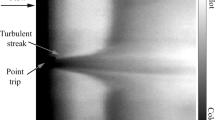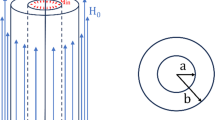Abstract
The volume integral method of eddy-current modeling represents a flaw in metal as a set of electric dipoles located within volume elements or cells defining the flaw volume. Given this dipole distribution, impedance changes may be computed. The electric field of the dipole distribution is determined by an integral equation relating, by means of the electric field Green's tensor, the electric field due to the source to the total electric field in the flaw. The integral equation is solved by assuming that the total electric field is constant in each volume element, resulting in a matrix equation. The method has been programmed for use on a microcomputer. The method and computer program are verified using the analytical solution for a small spherical flaw and three sets of measured impedance data, measured by air-core coils along profiles overlying both surface-breaking and buried simulated flaws of known dimensions. Operating frequencies ranged between 900 and 4000 Hz. Generally agreement is good at lower frequencies (∼ 1000 Hz). At higher frequencies (∼ 4000 Hz), the agreement is not as good. This is thought to be due to the inability of the constant electric field approximation to model the steep electric field gradients present in the host metal at high frequency. The results are also sensitive to the method of computation of the electric field due to the source. Some improvements can and should be made to the method.
Similar content being viewed by others
References
W. S. Dunbar, The volume integral method of eddy current modeling,J. Nondestruct. Eval. 5: 9–14 (1985).
B. A. Auld, Theoretical characterization and comparison of resonant probe microwave eddy-current methods, in G. Birnbaum and G. Free (eds.),Eddy Current Characterization of Materials and Structures, ASTM, Philadelphia (1981).
B. A. Auld, F. Muennemann, and D. K. Winslow, Eddy current probe response to open and closed surface flaws,J. Nondestruct. Eval. 2: 1–21 (1981).
A. J. M. Zaman, G. C. Gardner, and S. A. Long, Change in impedance of a single-turn coil due to a flaw in a conducting half space,J. Nondestruct. Eval. 3: 37–43 (1982).
A. P. Raiche and J. H. Coggon, Analytic Green's tensors for integral equation modeling,Geophys. J. Roy. Astron. Soc. 42: 1035–1038 (1975).
R. Beissner, Analytic Green's dyads for an electrically conducting half-space,J. Appl. Phys. 60: 855–858 (1986).
G. E. Forsythe, M. A. Malcolm, and C. Moler,Computer Methods for Mathematical Computations (Prentice-Hall, Englewood Cliffs, N.J., 1977).
C. V. Dodd and W. E. Deeds, Analytical solutions to eddy current probe coil problems,J. Appl. Phys. 39: 2829–2838 (1968).
J. van Bladel, Some remarks on Green's dyadic for infinite space,IRE Trans. Antennas Propagat. 9: 563–566 (1961).
P. Weidelt, Electromagnetic induction in three dimensions,J. Geophys. 41: 85–109 (1975).
M. L. Burrows,A Theory of Eddy Current Flaw Detection, Ph.D. thesis (University of Michigan, Ann Arbor, 1964).
S. K. Burke, A benchmark problem for computation of ΔZ in eddy-current nondestructive evaluation (NDE),J. Nondestruct. Eval. 7: 35–42 (1988).
S. A. Long, S. Toomsawasdi, and A. J. M. Zaman, Experimental measurements of the eddy current signal due to a flawed, conducting half space,Nondestruct. Test. Comm. 1: 105–110 (1983).
I. S. Gradshteyn and I. M. Ryzhik,Tables of Integrals, Series and Products (Academic Press, New York, 1980).
M. Abramowitz and I. Stegun,Handbook of Mathematical Functions (Dover, New York, 1965).
Author information
Authors and Affiliations
Rights and permissions
About this article
Cite this article
Dunbar, W.S. The volume integral method of eddy-current modeling: Verification. J Nondestruct Eval 7, 43–54 (1988). https://doi.org/10.1007/BF00565776
Received:
Revised:
Issue Date:
DOI: https://doi.org/10.1007/BF00565776




